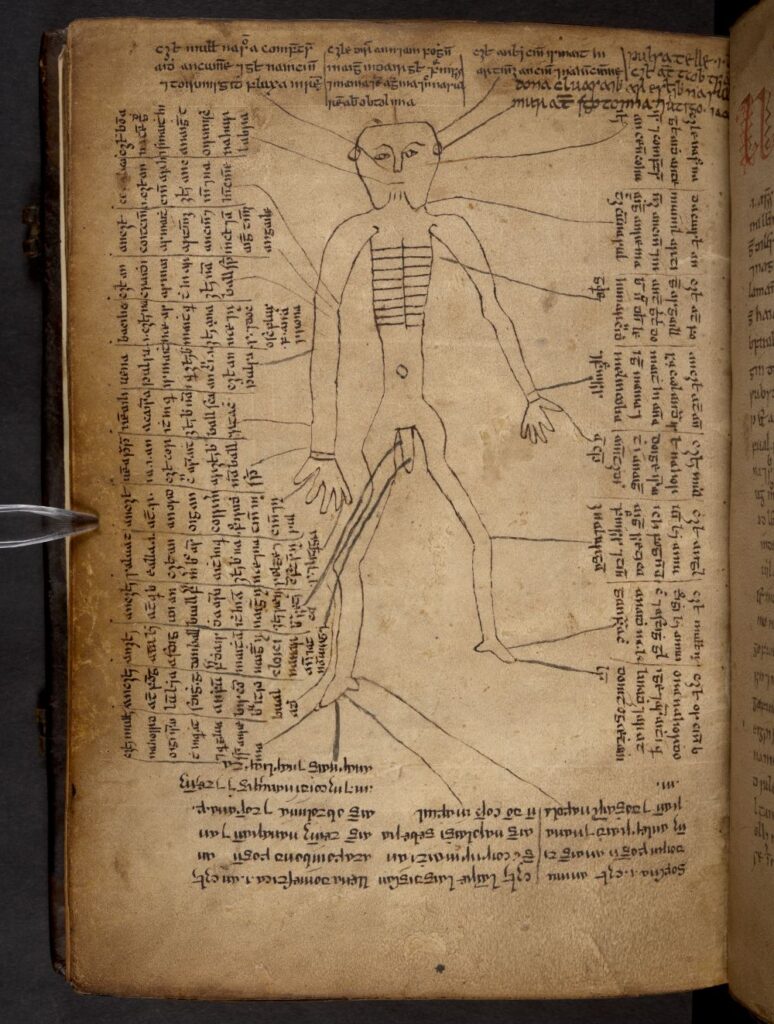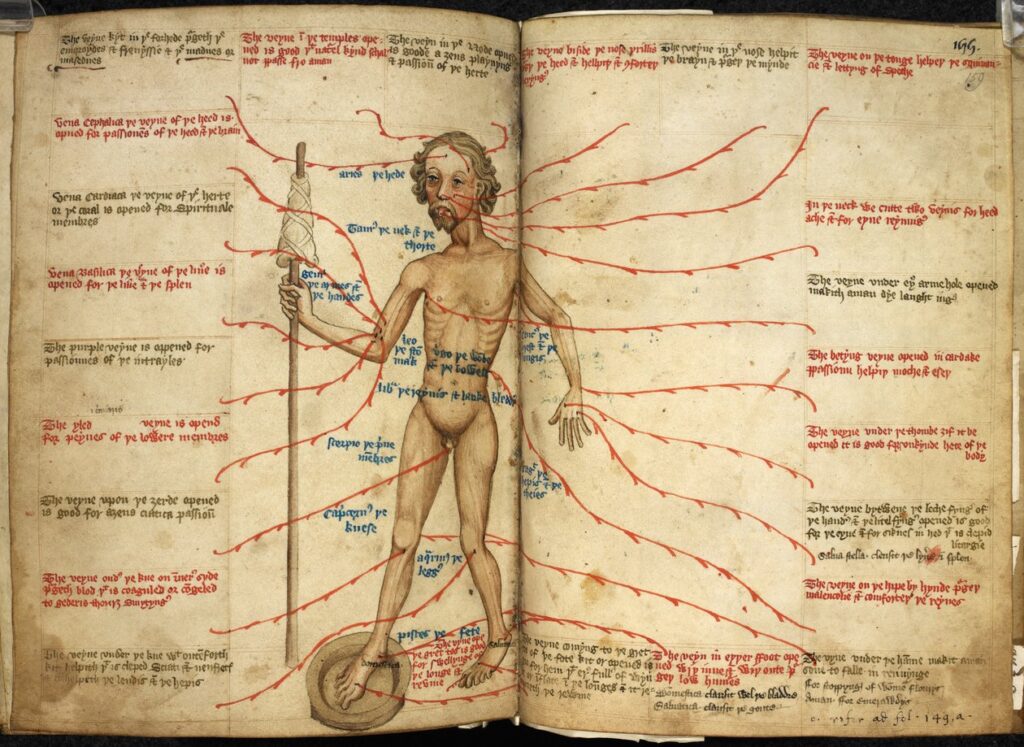London, British Library MS Add. 15582
Deborah Hayden

Figure 1: London, British Library MS Add. 15582, fol. 61v: a ‘Phlebotomy Man’, showing the appropriate places to bleed a patient for different illnesses. Image courtesy of the British Library.
This is a small manuscript consisting of 62 vellum folios that was written around the middle of the sixteenth century by one ‘Dáibhí Ó Cearnaigh’, who may have belonged to a well-known medical family of this name from Mayo and who noted, in a colophon on fol. 69, that he completed the book in 1563. He was assisted by two scribes who signed themselves as ‘Aedh’ and ‘Cairbre’, both of whom were likely from the Ó Ceannabháin medical kindred employed by the Uí Fhlaithbheartaigh rulers in south-east Connacht. These scribes wrote the manuscript for Eoin Mac Beatha (John Beaton), a member of the famous hereditary medical family of this name from Scotland. John Beaton was probably visiting the Ó Ceannabháin and other medical schools in the west of Ireland at the time; he also commissioned a second medical manuscript (now in Edinburgh University Library) from Cairbre Ó Ceannabháin and signed it mise Eoin ó Albain (‘I am John from Scotland’) on fol. 64r (see our Manuscript of the Month entry for March 2025). Only one location is mentioned in BL Add. MS 15582: on fol. 29v, Cairbre wrote a note apologising to Eoin for his handwriting and informing him that he was ‘on the move fleeing before the English throughout Coill Néill (‘Niall’s Wood’), and it is in this very wood that I have written part of it and prepared the vellum’. Siobhán Barrett has recently argued, on the basis of this reference and other medical manuscripts associated with Cairbre, that the woodland in question was in Tirawley, Co. Mayo.
It seems that John Beaton eventually brought the manuscript home to Islay, where he had the status of ollamh (‘professor’) of medicine, and it was then passed on to his descendants. In 1588 it was acquired by the physician James Beaton, who may have been employed by the MacDonalds of Sleat and been based at Portree. This James wrote a note on fol. 61r concerning the illness of the daughter of Macdougall son of Ranald, where he lamented: ‘great is my sadness today, for, as Galen says, the physician is but Nature’s imitator’. As John Bannerman (1998: 118) has observed, this passing remark offers us ‘a rare glimpse of the medieval doctor’s compassion for his patient and an even rarer admission of his fallibility.’
The contents of the Add. 15582 manuscript are miscellaneous. The first few folios contain tracts and excerpts concerned with regimen and diet, with notes on topics such as the correct quantity of food to be consumed, the order in which it should be taken and the appropriate hours of meals. This is followed by a short tract on the places in which to apply a cupping horn and instructions for performing cautery, as well as a copy of the prologue to the popular text known as the ‘Ivory Casket’, containing advice regarding the signs of approaching death. The prologue to this text describes how Hippocrates had the work buried in his tomb, where it was later discovered by Caesar, who passed it on to his personal physician.
BL Add. MS 15582 also contains one of the few images preserved in an Irish medical manuscript: on fol. 61v there is a phlebotomy chart consisting of a naked man with lines radiating to the margins of the page from the 26 points at which a vein might be opened (see Figure 1 above). At the end of each line is a short description of the vein and the afflictions that can be cured by letting it. For example, the line emanating from the top of the nose, corresponding to the text in the top left corner of the page, describes how letting this vein ‘helps the memory, and disease of the brain, and prevents effusion of rheum’ (comfurtachtaidh an cumne ocus galar na incinn[e] ocus toirmisgidh fluxa in réma). Although roughly sketched, this Irish version of a ‘phlebotomy man’ is similar to images found in other medical manuscripts of the later Middle Ages, such as the English source shown in Figure 2 below.

Figure 2: Phlebotomy man in London, British Library MS Harley 3719, fols 158v-159 (image courtesy of the British Library).
The Add. 15582 manuscript was fully digitised by the British Library for the LEIGHEAS project in October 2023 and will be made available Open Access in future via the Library’s Universal Viewer.
Further reading:
Bannerman, John (1998), The Beatons. A Medical Kindred in the Classical Gaelic Tradition (Edinburgh: John Donald)
Gillies, H. Cameron (1911), Regimen Sanitatis. The Rule of Health (London: British Library)
McCall, Taylor (2023), The Art of Anatomy in Medieval Europe (London: Reaktion Books)
O’Grady, Standish H. (1926, repr. 1992), Catalogue of Irish Manuscripts in the British Library [formerly British Museum], Volume 1 (London: British Museum; repr. Dublin: DIAS), pp. 262–80